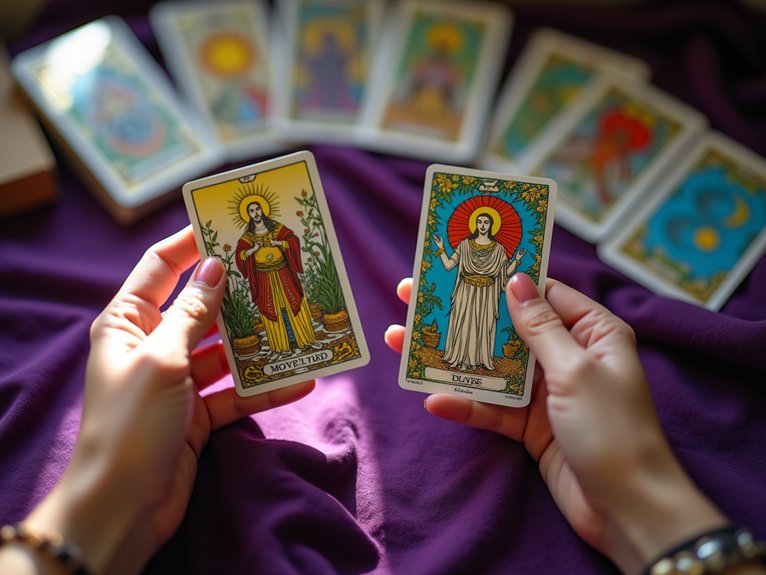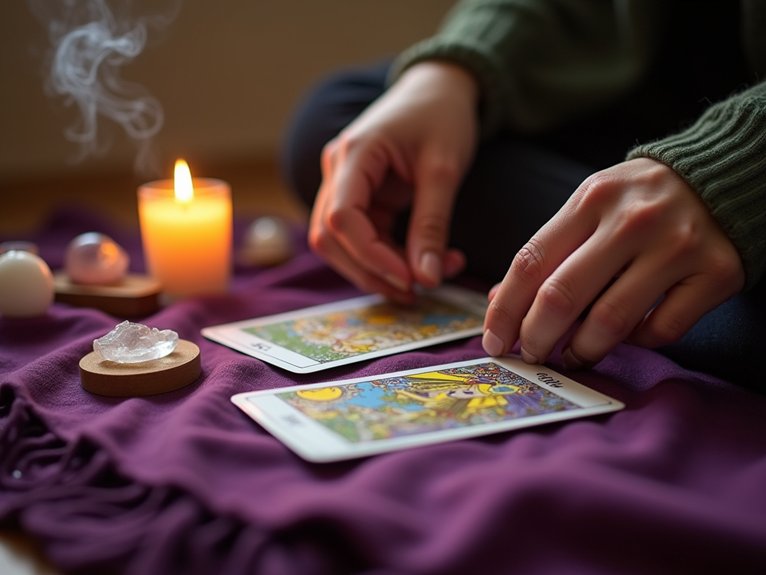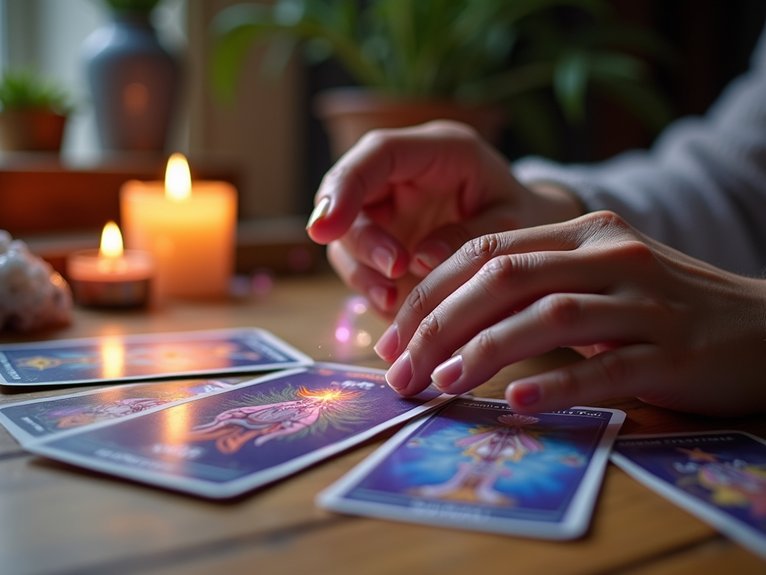Learning to read tarot or oracle cards begins with selecting a deck that resonates personally. Beginners often start with traditional tarot for its structured system and abundant resources, while oracle cards offer simpler symbolism. Creating a sacred practice space and establishing cleansing rituals enhances the experience. Mastering basic spreads like the single card pull or three-card layout builds confidence. Regular practice with journaling develops intuition beyond memorization. The journey from novice to interpreter unfolds through consistent engagement with the cards.
Choosing Your First Deck: Tarot vs. Oracle Cards

When beginning a journey into cartomancy, the first decision a novice reader faces is selecting between tarot and oracle cards. Tarot decks follow a structured system of 78 cards with established meanings and symbolism. This standardization provides beginners with consistent learning resources and traditional interpretations to build upon.
Oracle decks, conversely, offer greater flexibility with varied card counts and themes. They typically feature straightforward guidebooks and less complex symbolism, potentially making them more accessible for intuitive reading.
The ideal first deck resonates personally with the reader. Many practitioners recommend handling decks when possible to sense which system feels most natural and inviting.
Understanding the Basic Structure of Tarot Decks
Why does the tarot’s structure matter so fundamentally to beginning readers? Because this ancient system follows a consistent organization that creates the foundation for interpretation.
A traditional tarot deck contains 78 cards divided into two main sections: the Major Arcana (22 cards representing life’s spiritual lessons) and the Minor Arcana (56 cards in four suits).
The Minor Arcana suits—typically Cups, Pentacles, Swords, and Wands—correspond to elements and aspects of daily life. Each suit contains ten numbered cards plus four court cards (Page, Knight, Queen, King). Understanding this hierarchical arrangement helps readers recognize patterns and relationships between cards during readings.
Creating a Sacred Practice for Card Reading

A sacred practice forms the cornerstone of meaningful tarot and oracle card reading. Practitioners typically begin by creating a dedicated space free from distractions where cards can be handled with reverence. Many readers cleanse their decks with moonlight, incense, or crystal placement to remove accumulated energies.
Consistent rituals—such as lighting candles, meditation, or invocation—help establish boundaries between everyday consciousness and intuitive reading states. Regular practice at specific times or days strengthens this connection.
Journaling insights after readings preserves wisdom that might otherwise fade. This documentation creates a personal reference that deepens understanding and validates the reader’s developing relationship with their cards.
Simple Spreads for Beginners to Master
Simple Spreads for Beginners to Master
With a sacred practice established, beginners benefit from starting with straightforward card layouts that build confidence and skill. The single card pull offers the simplest entry point—drawing one card with a focused question to interpret its isolated meaning.
The three-card spread expands complexity while remaining accessible. Common interpretations include past-present-future, situation-action-outcome, or mind-body-spirit dynamics.
For those ready for slightly more depth, the five-card cross provides additional context while remaining manageable. Position meanings typically include present situation, challenges, past influences, potential outcomes, and advice.
Beginners should master these foundational spreads before attempting the more complex Celtic Cross or other advanced layouts.
Developing Your Intuitive Connection With Cards

Beyond memorizing card meanings lies the true essence of tarot reading—developing one’s intuitive connection with the cards. This intuitive bond forms through consistent practice and personal reflection.
Readers can strengthen this connection by meditating with cards, keeping a tarot journal, or practicing single-card daily draws. Trusting first impressions when viewing a card often reveals subconscious insights that pure memorization cannot access.
Another effective technique is storytelling—connecting cards in a spread through narrative rather than isolated interpretations. Readers should honor their unique impressions, even when they differ from textbook definitions. The most powerful readings emerge when technical knowledge harmonizes with intuitive wisdom.
Common Symbols and Their Interpretations
Tarot and oracle cards utilize recurring symbols that carry universal meanings across different decks and traditions. Elements like fire, water, air, and earth represent different energies and temperaments. The sun typically symbolizes clarity and success, while the moon reflects intuition and subconscious knowledge.
Animals carry specific meanings—lions denote courage, snakes transformation, and birds freedom. Numerology plays a pivotal role, with each number holding distinct vibrations. Colors also convey meaning: red for passion, blue for communication, and purple for spiritual insight.
Understanding these universal symbols creates a foundation for accurate readings regardless of which deck one chooses to work with.
Keeping a Card Reading Journal
Building upon knowledge of universal symbols, practitioners can considerably enhance their intuitive abilities by maintaining a card reading journal. This record serves as a personal reference documenting interpretations, insights, and patterns observed during readings.
Effective journals typically include the date, deck used, question posed, cards drawn, initial impressions, and subsequent outcomes. Many readers photograph their spreads to accompany written notes.
Regular journaling reveals personal connections to specific cards, highlights recurring themes across readings, and tracks one’s development as an intuitive reader. Through consistent documentation, practitioners develop a unique interpretive vocabulary that bridges traditional meanings with personal understanding, ultimately deepening their practice.
Ethical Considerations for Reading Cards
When engaging with divination practices, practitioners must recognize the significant responsibility they hold toward those seeking guidance. Ethical readers maintain client confidentiality, avoid making absolute predictions about health, death, or legal matters, and refrain from creating dependency.
Readers should clearly communicate that cards offer perspectives rather than fixed futures, empowering clients to exercise free will. Setting reasonable fees, obtaining informed consent before readings, and acknowledging personal limitations demonstrate integrity.
For beginners, practicing with close friends while establishing boundaries creates a foundation for ethical practice. Ultimately, responsible card reading serves to illuminate paths, not dictate destinations.
Resources to Deepen Your Card Reading Practice
A dedicated card reader’s journey extends well beyond acquiring their first deck. Serious practitioners benefit from investing in thorough guidebooks specific to their chosen system, whether tarot, oracle, or Lenormand cards.
Online communities provide valuable support through forums, social media groups, and video tutorials where readers share interpretations and techniques. Advanced courses taught by experienced readers offer structured learning environments.
Journaling practices help track personal symbol development and reading accuracy over time. Reference libraries containing books on symbolism, psychology, and cultural history provide contextual depth to readings.
Regular practice with trusted feedback remains the most essential resource for any developing card reader.



